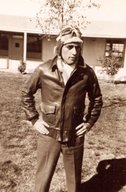
|

|
|
|
|
Maynard was born in Milwaukee, Wisconsin, the only child to John Park, a barber and infantry veteran of World War I, and Cora Greeno Park. When he was three, the family moved to La Crosse, Wisconsin. Maynard worked on his grandfather's farm, where he plowed and milked cows among other chores. "It taught me nothing is for nothing. You had to work for it," he says of his experience on the farm. A gifted athlete, Maynard played basketball, football, and baseball, and hoped to be a professional pitcher. The Japanese attack on Pearl Harbor changed his plans. He describes that event as "the jolt that started a whole `nother life for me." Maynard graduated from Central High School in June of 1943, and joined the U.S. Army Air Forces hoping to fly. He was sent to Sheppard Field in Wichita Falls, Texas, for basic training. "I liked the military; it grew on me," he says. He was selected as a pilot trainee and took two months of ground school. Selected for a college training detachment he was sent to Henderson State Teachers College in Arkadelphia, Arkansas, where he took college courses for three months. He went through primary flight school at Fort Stockton, Texas, basic flying school at Goodfellow Field in San Angelo, Texas, and advanced flight training at Lubbock Army Air Force Base, where he graduated on May 23, 1944. In Rapid City, South Dakota, where bomber crews were assembled, he joined a B-17 crew. At Bury St. Edmunds in England in October of 1944 he was placed in the 410th Bombardment Squadron, 94th Bombardment WIng. Maynard spent a year flying 35 combat missions, many lasting from five to more than seven hours in length. He went on leave to London where he heard or saw V-1 or V-2 rockets, "almost every night." The English civilians "were terrific," he recalls. "The people that lived right there were just wonderful," he says of residents near his base. "They'd do anything for you." He returned to the States in "May or June" of 1945. He was sent to Sioux Falls, South Dakota, for reclassification. He left the service 15 days before turning 21. Maynard still yearning to be a professional baseball player, he earned a spot in the Wisconsin State League in 1946, his first year of professional baseball. He played until he tore his rotator cuff in 1951, "And that was the end of my baseball," he says. He married on August 3, 1951. He and his wife, Olene, would have four children, seven grandchildren, and two great-grandchildren. He returned to the air force in 1953 and was assigned to the 509th Bombardment Wing at Walker Air Force Base in Roswell, New Mexico. He flew B-50s, then the B-47. In 1957 he joined the 11th Bombardment Wing at Castle Air Force Base and transitioned to the B-52 and sent to Altus, Oklahoma. In all, he chalked up 6,300 hours in the B-52. Maynard spent a three-year tour at Barksdale Air Force Base from 1965 to 1968. He next served as bomb squadron commander at Grand Forks, North Dakota, in the 319th Bombardment Wing. Meanwhile he finished college through the Boot Strap program, earning his degree in 1971. He spent all of 1972 at Strategic Air Command (SAC). He then transferred into security police, by then a lieutenant colonel. Maynard spent the last years of his air force duty at Barksdale. He retired in 1978, entered financial planning, and sold insurance and securities for 15 years. "It was an experience that I'm glad that I was in it," he says of World War II and his service. "I cherish it. I was glad that I was born when I was because I was part of something that was pretty big. I'd do it all over again." |


